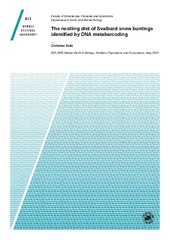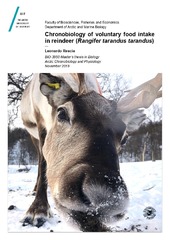Institutt for arktisk og marin biologi: Nye registreringer
Viser treff 1241-1260 av 2050
-
The nestling diet of Svalbard snow buntings identified by DNA metabarcoding
(Master thesis; Mastergradsoppgave, 2019-05-15)Tundra arthropods have considerable ecological importance as a food source for several bird species that are reproducing in the Arctic. The actual arthropod taxa comprising the chick diet are however rarely known, complicating assessments of ecological interactions. In this study, I identified the nestling diet of Svalbard snow bunting (Plectrophenax nivalis) for the first time. Faecal samples of ... -
Thermal behaviour of edible crab Cancer pagurus Linnaeus, 1758 in coastal Norway
(Journal article; Tidsskriftartikkel; Peer reviewed, 2019-02-26)Ocean warming drives latitudinal shifts in the distribution of ectotherm species. The rate and magnitude of such shifts are constrained by physiology and behavioural thermoregulation. Here, we investigated the thermal preference and lower critical temperature (CTmin) in female edible crab <i>Cancer pagurus</i>, a decapod crustacean with an ongoing northward dispersal along the Norwegian coast. The ... -
Can waste re-cycling increase the sustainability of animal feeds?
(Journal article; Tidsskriftartikkel, 2019)An annual procution of over one billion tonnes, and an economic turnover in excess of $US400 billion; this is the animal feed industry. The vast majority of animal feed is given to terrestrial farm animals; those reared for meat, and those used to produce eggs and dairy products. Fish feeds make up about 5% of the total volume of animal feeds and have a 10% share of marked sales. <p> <p>It is ... -
Chronobiology of voluntary food intake in reindeer (Rangifer tarandus tarandus)
(Master thesis; Mastergradsoppgave, 2018-11-15)In all organisms, biological rhythms arise from the interaction between endogenous clocks and a rhythmic environment. The timing of sunrise and sunset synchronize internal timing processes and inform the organism not only of the time of day, but also of the time of year. For animals living in polar regions biological timekeeping represents a challenge, given that the sun does not rise during the ... -
The Marine Plastic Microbiome: Microbial Colonization of Polymer Surfaces in the Arctic Marine Environment
(Master thesis; Mastergradsoppgave, 2018-09-25)While the sources and fates of plastic pollution are receiving growing attention, major knowledge gaps exist. Among these, microbial degradation (aka biodegradation) of plastics remains poorly investigated. The process of biodegradation begins with the formation of biofilm on the polymer surface; our study aimed to investigate microbial colonization of polymer surfaces in the Arctic marine environment ... -
Evaluating the use of biotic interactions in species distribution models
(Master thesis; Mastergradsoppgave, 2018-08-15)Species distribution models are a key tool in predicting and projecting population changes in the past, present and future. In the past they have mostly focused on using abiotic interactions for their models. This may be inadequate however as biotic interactions play an important role in determining community composition. Climate change has created and will create many novel communities that have ... -
No support for cryptic choice by ovarian fluid in an external fertilizer
(Journal article; Tidsskriftartikkel; Peer reviewed, 2018-12-22)Whether the ovarian fluid (OF) represents a selective environment influencing cryp‐tic female choice was tested using an external fertilizer experiencing intense sperm competition and large effects of OF on sperm swimming behavior—the Arctic charr (<i>Salvelinus alpinus</i>). We physically separated the OF from the eggs of reproductively active females and reintroduced either their ... -
Causes and consequences of ontogenetic dietary shifts: a global synthesis using fish models
(Journal article; Tidsskriftartikkel; Peer reviewed, 2018-09-24)Ontogenetic dietary shifts (ODSs), the changes in diet utilisation occurring over the life span of an individual consumer, are widespread in the animal kingdom. Understanding ODSs provides fundamental insights into the biological and ecological processes that function at the individual, population and community levels, and is critical for the development and testing of hypotheses around key concepts ... -
Prevalence of brucellosis among patients attending Wau Hospital, South Sudan
(Journal article; Tidsskriftartikkel; Peer reviewed, 2018-06-27)Brucellosis is a zoonotic disease of public health importance; its prevalence varies globally. In low-income countries, brucellosis is an endemic and neglected disease affecting both animals and humans. This study was intended to establish brucellosis sero-prevalence among patients attending Wau hospital, South Sudan. Across sectional study, was done among randomly selected patients attending Wau ... -
Getting ready for the winter: timing and determinants of molt in an alpine ungulate
(Journal article; Tidsskriftartikkel; Peer reviewed, 2019-02-14)Because growth of new hairs entails energetic costs, individual condition and access to food should determine the timing of molt. Previous studies on the timing of molt in ungulates have mostly focused on the influence of age class and reproductive status, but the effects of body condition and environmental phenology have not been evaluated. Our goal was to assess how intrinsic traits and environmental ... -
Immunological response to Brucella abortus strain 19 vaccination of cattle in a communal area in South Africa
(Journal article; Tidsskriftartikkel; Peer reviewed, 2018-03-29)Brucellosis is of worldwide economic and public health importance. Heifer vaccination with live attenuated <i>Brucella abortus</i> strain 19 (S19) is the cornerstone of control in low- and middle-income countries. Antibody persistence induced by S19 is directly correlated with the number of colony-forming units (CFU) per dose. There are two vaccination methods: a ‘high’ dose (5–8 × 10<sup>10</sup> ... -
Characterization of Microbial Communities in Pilot-Scale Constructed Wetlands with Salicornia for Treatment of Marine Aquaculture Effluents
(Journal article; Tidsskriftartikkel; Peer reviewed, 2018-04-29)Microorganisms play an essential role in the performance of constructed wetlands (CWs) for wastewater treatment. However, there has been limited discussion on the characteristics of microbial communities in CWs for treatment of effluents from marine recirculating aquaculture systems (RAS). This study is aimed at characterizing the microbial communities of pilot-scale CWs with <i>Salicornia bigelovii</i> ... -
Biogenic silica production and diatom dynamics in the Svalbard region during spring
(Journal article; Tidsskriftartikkel; Peer reviewed, 2018-11-06)Diatoms are generally the dominant contributors to the Arctic Ocean spring bloom, which is a key event in regional food webs in terms of capacity for secondary production and organic matter export. Dissolved silicic acid is an obligate nutrient for diatoms and has been declining in the European Arctic since the early 1990s. The lack of regional silicon cycling information precludes understanding the ... -
Holistic Assessment of Rumen Microbiome Dynamics through Quantitative Metatranscriptomics Reveals Multifunctional Redundancy during Key Steps of Anaerobic Feed Degradation
(Journal article; Tidsskriftartikkel; Peer reviewed, 2018-08-07)Ruminant livestock is a major source of the potent greenhouse gas methane. The complex rumen microbiome, consisting of bacteria, archaea, and microbial eukaryotes, facilitates anaerobic plant biomass degradation in the cow rumen, leading to methane emissions. Using an integrated approach combining multidomain quantitative metatranscriptomics with gas and volatile fatty acid (VFA) profiling, we ... -
Drivers of diet patterns in a globally distributed freshwater fish species
(Journal article; Tidsskriftartikkel; Peer reviewed, 2018-09-24)We analysed data of a globally distributed model organism (brown trout) in an attempt to understand relationships among biogeography, prey communities and climate on diet composition at regional spatial scales (Scandinavia), and thereafter explored whether diet patterns remained the same at global scales. At regional scales, we uncovered comprehensive patterns in diet composition among neighbouring ... -
The role of trust in sustainable management of land, fish, and wildlife populations in the Arctic
(Journal article; Tidsskriftartikkel; Peer reviewed, 2018-09-01)Sustainable resource management depends on support from the public and local stakeholders. Fish, wildlife, and land management in remote areas face the challenge of working across vast areas, often with limited resources, to monitor land use or the status of the fish-and-wildlife populations. Resource managers depend on local residents, often Indigenous, to gain information about environmental ... -
The sero-prevalence of brucellosis in cattle and their herders in Bahr el Ghazal region, South Sudan
(Journal article; Tidsskriftartikkel; Peer reviewed, 2018-06-20)<i>Background</i>: Brucellosis is a worldwide recognized bacterial zoonotic disease. There is currently no information on bovine brucellosis sero-prevalence in South Sudan regardless of the economic, social and public health impact on populations. Therefore, for the first time in 33 years, we report the sero-prevalence of brucellosis in cattle and their herders. Furthermore, we characterize the ... -
Traditional plant functional groups explain variation in economic but not size‐related traits across the tundra biome
(Journal article; Tidsskriftartikkel; Peer reviewed, 2018-11-16)<p><i>Aim - </i>Plant functional groups are widely used in community ecology and earth system modelling to describe trait variation within and across plant communities. However, this approach rests on the assumption that functional groups explain a large proportion of trait variation among species. We test whether four commonly used plant functional groups represent variation in six ecologically ... -
Do mothers also "manipulate" grandparental care?
(Journal article; Tidsskriftartikkel; Peer reviewed, 2018-11-15)Paternity uncertainty has proven to be a robust ultimate hypothesis for predicting the higher investment in grandchildren observed among maternal grandparents compared to that of the paternal grandparents. Yet the proximate mechanisms for generating such preferred biases in grandparental investment remain unclear. Here we address two different questions for better understanding the proximate mechanisms ... -
Habitats and movement patterns of white whales Delphinapterus leucas in Svalbard, Norway in a changing climate
(Journal article; Tidsskriftartikkel; Peer reviewed, 2018-10-24)Background: The Arctic is experiencing rapid reductions in sea ice and in some areas tidal glaciers are melting and retracting onto land. These changes are occurring at extremely rapid rates in the Northeast Atlantic Arctic. The aim of this study was to investigate the impacts of these environmental changes on space use by white whales (Delphinapterus leucas) in Svalbard, Norway. Using a unique ...


 English
English norsk
norsk


















